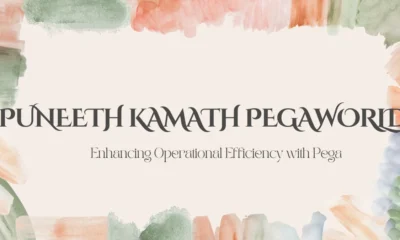BUSINESS
Five Technology Opportunities Available for Businesses in 2025

We are living in a time of rapid technological advancement, the likes of which have rarely been seen throughout history. As such, companies and businesses must adopt the technological opportunities that arise, lest they risk being left behind. As unprecedented developments are occurring in a wide range of technology fields this article will address how businesses can capitalize on this tech and improve their company through utilizing it.
Number One: Cryptocurrency
Cryptocurrency is already a hugely popular asset in the US, and its adoption by US citizens is expected to rise at an exponential rate. Recent statistics documented that around 28% of Americans, the equivalent of 65.7 million people, own cryptocurrency. The reasons for the rising popularity of these digital assets are many, including everything from security to the volatility of these coins (meaning the tendency they have to rise or fall in value over time). Businesses are encouraged to incorporate crypto payments into their day-to-day running to appeal to a larger scale of service users or customers. Having the opportunity to pay in cryptocurrency is a great benefit for many individuals and is certain to improve the overall popularity and acceptance of a business. Already multiple industries have proven that they benefit from crypto acceptance.
For example, many online casinos have already integrated cryptocurrency into their sites, and can offer the multiple benefits doing so entails to their customers. These benefits include rapid transactions and anonymous gambling. Similarly, the e-commerce market has adopted crypto, which gives customers the benefit of low transaction fees on international payments. This has helped these websites reach a larger customer base on a global scale and has improved the overall popularity of the industry.
Number Two: Artificial Intelligence
Artificial intelligence has been present for a while, but the developments it has seen recently have been astronomical. Now, AI is firmly integrated into our search engines, our mobiles, and countless company websites. If companies adopt AI effectively, they can experience hugely positive effects on the day-to-day running of their business. Not only can AI act as a 24/7 customer service assistant, able to provide round-the-clock help to every customer, but it can also play an active role in the organization of the business itself. These intelligent machines can take care of countless aspects of a business, including accounting, waste, managing stock levels, and predicting demand. Additionally, the integration of AI into a business is now easier than ever before, with many companies offering their own AI for others to implement. Unsurprisingly, thousands of companies within the e-commerce landscape, such as Amazon, have integrated AI and have seen increased sales as a result.
Number Three: Virtual Reality
Virtual reality, or augmented reality, is a computer-generated environment that people can interact with no matter their true location. Such technology has already provided many businesses with substantial advantages over their contemporaries who have not yet integrated the technology. Virtual reality can be utilized in many of the different fields involved with running a business. For example, this technology can create immersive environments for colleague training purposes, or allow customers to see a company’s products in the space, such as within their home or on their person, where the item will be utilized.
VR has also proved incredibly beneficial for product design and prototyping, allowing developers to see their product in action before its physical creation. Businesses are encouraged to capitalize on the variety of uses that virtual reality provides, as doing so will improve not only the customer experience but also the experience of colleagues, stakeholders, and the company itself. Two of the many industries that have already significantly benefited from the integration of virtual reality include healthcare, where medical training and surgery planning can be conducted in a safe, virtual environment, and real estate where potential homeowners can attend interactive tours of the property they wish to purchase without having to leave their current location.
Number Four: Security
Security should be at the forefront of all companies minds. As technology advances, so does the technology available to hackers and scammers which is why protecting personal information is more important than ever before. Companies should ensure their security measures are up to date and working effectively at all times, not only for the safety of the business itself but for its workers and its customers. There are a variety of different ways that companies can utilize modern technology to ensure the overall security of their business.
For example, keeping sensitive information behind complex verification systems, such as multi-factor authentication and biometric face recognition, is an excellent way to ensure the continued safety of personal information. Additionally, technologies such as the blockchain are not limited only to cryptocurrency. Companies can use this system to ensure the security of their business transactions, encrypting them from potential threats. In light of the growth of digital threats, many industries make use of the complex security systems available, especially companies that hold sensitive information for their customers such as banks and digital wallets.
Number Five: The Internet of Things (IoT)
The Internet of Things (IoT) refers to modern technology that allows for multiple appliances to be connected and thus communicate with one another in real time. For example, a ‘smart home’ that automatically dims and brightens the lights depending on the environment or that raises or lowers the heating based on the temperature sensed utilizes an Internet of Things. In business, the Internet of Things can be used differently, to analyze data and respond to its findings without the need for human interaction.
Businesses that are required to make decisions based on a changing environment are encouraged to make use of the Internet of Things to better streamline this process. Examples of other companies that have benefited from this kind of technology include agriculture and retail. An example of the Internet of Things effect on the agriculture industry involves ensuring that actions, such as watering plants, are performed immediately after issues in plant health are detected, without the need for human intervention. Similarly, if used in retail, the Internet of Things can inform a store manager of low stock in real-time, ensuring the shelf never goes empty and customer demand is always met.
Conclusion
Technology is advancing at an unprecedentedly rapid pace, constantly providing businesses with new opportunities for innovation and growth. In the increasingly digital and technologically driven world we inhabit companies must capitalize on the technology that is available to them, or risk falling behind their competitors. As discussed, technology can improve the overall function of a business as well as enhance customer experience and security. Integrating these technologies enables companies not only to unlock new levels of efficiency but remain present and relevant in a rapidly changing world.
-

 BIOGRAPHY6 months ago
BIOGRAPHY6 months agoBehind the Scenes with Sandra Orlow: An Exclusive Interview
-

 HOME1 year ago
HOME1 year agoDiscovering Insights: A Deep Dive into the //vital-mag.net blog
-

 HOME1 year ago
HOME1 year agoSifangds in Action: Real-Life Applications and Success Stories
-

 BIOGRAPHY1 year ago
BIOGRAPHY1 year agoThe Woman Behind the Comedian: Meet Andrew Santino Wife




























